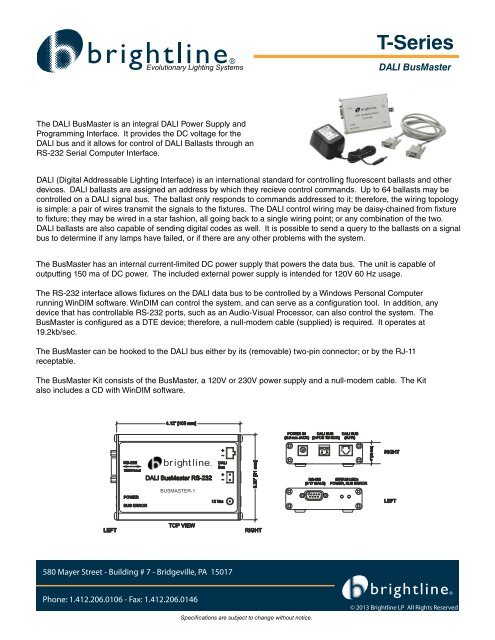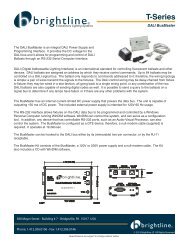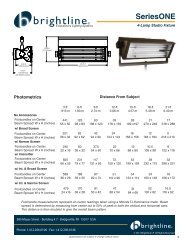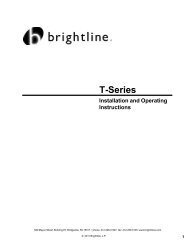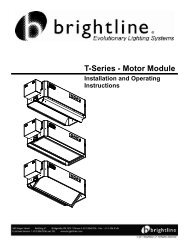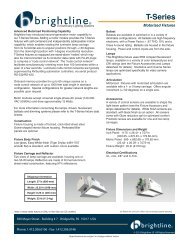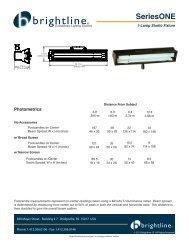BusMaster RS-232 to DALI Converter Datasheet - Brightline
BusMaster RS-232 to DALI Converter Datasheet - Brightline
BusMaster RS-232 to DALI Converter Datasheet - Brightline
Create successful ePaper yourself
Turn your PDF publications into a flip-book with our unique Google optimized e-Paper software.
T-Series<br />
<strong>DALI</strong> <strong>BusMaster</strong><br />
The <strong>DALI</strong> <strong>BusMaster</strong> is an integral <strong>DALI</strong> Power Supply and<br />
Programming Interface. It provides the DC voltage for the<br />
<strong>DALI</strong> bus and it allows for control of <strong>DALI</strong> Ballasts through an<br />
<strong>RS</strong>-<strong>232</strong> Serial Computer Interface.<br />
<strong>DALI</strong> (Digital Addressable Lighting Interface) is an international standard for controlling fluorescent ballasts and other<br />
devices. <strong>DALI</strong> ballasts are assigned an address by which they recieve control commands. Up <strong>to</strong> 64 ballasts may be<br />
controlled on a <strong>DALI</strong> signal bus. The ballast only responds <strong>to</strong> commands addressed <strong>to</strong> it; therefore, the wiring <strong>to</strong>pology<br />
is simple: a pair of wires transmit the signals <strong>to</strong> the fixtures. The <strong>DALI</strong> control wiring may be daisy-chained from fixture<br />
<strong>to</strong> fixture; they may be wired in a star fashion, all going back <strong>to</strong> a single wiring point; or any combination of the two.<br />
<strong>DALI</strong> ballasts are also capable of sending digital codes as well. It is possible <strong>to</strong> send a query <strong>to</strong> the ballasts on a signal<br />
bus <strong>to</strong> determine if any lamps have failed, or if there are any other problems with the system.<br />
The <strong>BusMaster</strong> has an internal current-limited DC power supply that powers the data bus. The unit is capable of<br />
outputting 150 ma of DC power. The included external power supply is intended for 120V 60 Hz usage.<br />
The <strong>RS</strong>-<strong>232</strong> interface allows fixtures on the <strong>DALI</strong> data bus <strong>to</strong> be controlled by a Windows Personal Computer<br />
running WinDIM software. WinDIM can control the system, and can serve as a configuration <strong>to</strong>ol. In addition, any<br />
device that has controllable <strong>RS</strong>-<strong>232</strong> ports, such as an Audio-Visual Processor, can also control the system. The<br />
<strong>BusMaster</strong> is configured as a DTE device; therefore, a null-modem cable (supplied) is required. It operates at<br />
19.2kb/sec.<br />
The <strong>BusMaster</strong> can be hooked <strong>to</strong> the <strong>DALI</strong> bus either by its (removable) two-pin connec<strong>to</strong>r; or by the RJ-11<br />
receptable.<br />
The <strong>BusMaster</strong> Kit consists of the <strong>BusMaster</strong>, a 120V or 230V power supply and a null-modem cable. The Kit<br />
also includes a CD with WinDIM software.<br />
4.12” [105 mm]<br />
POWER IN <strong>DALI</strong> BUS <strong>DALI</strong> BUS<br />
(2.5 mm JACK) (2-POS TB HDR) (RJ11)<br />
<strong>RS</strong>-<strong>232</strong><br />
19200 baud<br />
POWER<br />
BUS ERROR<br />
br ightline®<br />
<strong>DALI</strong> <strong>BusMaster</strong> <strong>RS</strong>-<strong>232</strong><br />
BUSMASTER-1<br />
<strong>DALI</strong><br />
Bus<br />
12 Vac<br />
3.20” [81 mm]<br />
<strong>RS</strong>-<strong>232</strong><br />
(9 'D' MALE)<br />
STATUS LEDs<br />
POWER, BUS ERROR<br />
1” [25 mm]<br />
RIGHT<br />
LEFT<br />
LEFT<br />
TOP VIEW<br />
RIGHT<br />
580 Mayer Street - Building # 7 - Bridgeville, PA 15017<br />
Phone: 1.412.206.0106 - Fax: 1.412.206.0146<br />
Specifications are subject <strong>to</strong> change without notice.<br />
© 2013 <strong>Brightline</strong> LP All Rights Reserved
T-Series<br />
<strong>DALI</strong> <strong>BusMaster</strong><br />
Win-Dim Software<br />
WinDIM Software is intended <strong>to</strong> be used with the <strong>DALI</strong> <strong>BusMaster</strong> or the <strong>DALI</strong> Serial Programming Interface. It helps the installer configure a<br />
<strong>DALI</strong> System and after configuration provides for a user interface <strong>to</strong> control <strong>DALI</strong> Fixtures, Groups and Scenes.<br />
If the <strong>DALI</strong> Lighting System was purchased without Control Stations or other methods of setting the lighting looks, WinDIM can operate on a<br />
Windows PC. WinDIM runs in the background and adds an icon <strong>to</strong> the System Tray. The user can make changes <strong>to</strong> a Group or <strong>to</strong> a Scene<br />
online. After the changes have been made, the program will go back <strong>to</strong> operating in the background.<br />
Configuration<br />
The first step in configuring a <strong>DALI</strong> system is <strong>to</strong> make sure that all of the ballasts are addressed properly. As you configure the fixtures, make a<br />
note of the addresses.<br />
In complex installations, you may want <strong>to</strong> add the fixtures <strong>to</strong> Groups. A Group consists of one or more fixtures that will always have the same<br />
lighting level. Using Groups can simplify the setup procedure. WinDIM provides a graphic <strong>to</strong>ol <strong>to</strong> assign the fixtures <strong>to</strong> groups. A <strong>DALI</strong> System<br />
can have up <strong>to</strong> 16 Groups; WinDIM allows you <strong>to</strong> assign names <strong>to</strong> your groups if you wish.<br />
A Scene on <strong>DALI</strong> is a lighting “look” that can be chosen by the user for<br />
a specific purpose. Once a Scene is selected, the dimming levels of<br />
the fixtures assigned <strong>to</strong> that Scene are selected and the dimming levels<br />
of the fixtures assigned <strong>to</strong> that Scene are recalled and set. As with the<br />
Groups, WinDIM provides a <strong>to</strong>ol <strong>to</strong> set up and record Scenes. Up <strong>to</strong> 16<br />
Scenes can be set.<br />
Operation<br />
As mentioned above, WinDIM can be used as the primary controller<br />
for a <strong>DALI</strong> system. The screen <strong>to</strong> the right shows what you will see on<br />
your computer moni<strong>to</strong>r. The but<strong>to</strong>ns labeled G1 through G16 allow for<br />
control of the Groups. When a Group but<strong>to</strong>n is selected, its color will<br />
change from grey <strong>to</strong> green, indicating that it is active.<br />
Using the pull-down box labeled “Go <strong>to</strong> Scene”, make a selection. The<br />
lights will go <strong>to</strong> the levels set for that Scene. Selecting other Scenes<br />
will make the lights go <strong>to</strong> the new levels. The use of the four arrow<br />
but<strong>to</strong>ns in the center allows you <strong>to</strong> temporarily override the levels in<br />
the Scene. The On/Off but<strong>to</strong>n allows you <strong>to</strong> <strong>to</strong>ggle the lights On or Off.<br />
If you don’t want a Group <strong>to</strong> be involved in changes you are making,<br />
deselect the Group number. For example, if Group2 is not selected,<br />
its fixtures will not react <strong>to</strong> the “Go <strong>to</strong> Scene” command.<br />
The Properties but<strong>to</strong>n opens a series of Tab Pages that are used in<br />
the Configuration process as described above.<br />
Clicking anywhere on your moni<strong>to</strong>r outside of the WinDIM box “hides” this display, and returns <strong>to</strong> normal Windows<br />
operation.<br />
System Status<br />
You can query all of the fixtures on a <strong>DALI</strong> bus for any operational errors. WinDIM will indicate any error conditions that<br />
exist. For example, if a lamp is faulty, it will be reported back.<br />
Light Over Time<br />
One of the useful functions of WinDIM is the Light Over Time mode. It allows for up <strong>to</strong> five groups of lights <strong>to</strong> dynamically<br />
change intensities of the groups that follow the values set on the graph. This function is particularly valuable when used<br />
with Red, Green, Blue or Red, Green, Blue, White color-changing fluorescent fixtures.<br />
580 Mayer Street - Building # 7 - Bridgeville, PA 15017<br />
Phone: 1.412.206.0106 - Fax: 1.412.206.0146<br />
Specifications are subject <strong>to</strong> change without notice.<br />
© 2013 <strong>Brightline</strong> LP All Rights Reserved


